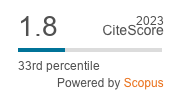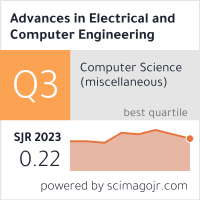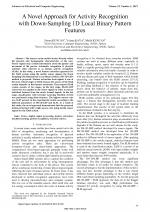| 1/2019 - 5 |
A Novel Approach for Activity Recognition with Down-Sampling 1D Local Binary Pattern FeaturesKUNCAN, F. |
| View the paper record and citations in |
| Click to see author's profile in |
| Download PDF |
Author keywords
digital signal processing, feature extraction, machine learning, pattern recognition, wearable sensors
References keywords
activity(24), recognition(20), human(20), learning(12), applications(11), sensors(10), classification(10), wearable(9), systems(9), machine(9)
Blue keywords are present in both the references section and the paper title.
About this article
Date of Publication: 2019-02-28
Volume 19, Issue 1, Year 2019, On page(s): 35 - 44
ISSN: 1582-7445, e-ISSN: 1844-7600
Digital Object Identifier: 10.4316/AECE.2019.01005
Web of Science Accession Number: 000459986900005
SCOPUS ID: 85064195416
Abstract
The sensors on the mobile devices directly reflect the physical and demographic characteristics of the user. Sensor signals may contain information about the gender and movement of the person. Automatic recognition of physical activities often referred to as human activity recognition (HAR). In this study, a novel feature extraction approach for the HAR system using the mobile sensor signals, the Down Sampling One Dimensional Local Binary Pattern (DS-1D-LBP) method is proposed. Feature extraction from signals is one of the most critical stages of HAR because the success of the HAR system depends on the features extraction. The proposed HAR system consists of two stages. In the first stage, DS-1D-LBP conversion was applied to the sensor signals in order to extract statistical features from the newly formed signals. In the last stage, classification with Extreme Learning Machine (ELM) was performed using these features. The highest success rate was 96.87 percent in the experimental results according to the different parameters of DS-1D-LBP and ELM. As a result of this study, the novel approach demonstrated that the proposed model performed with a high success rate using mobile sensor signals for the HAR system. |
| References | | | Cited By «-- Click to see who has cited this paper |
| [1] N. Gyorbíro, A. Fabian, G. Homanyi, "An activity recognition system for mobile phones," Mobile Networks and Applications, vol. 14, no. 1, pp. 82-91, February 2009. [CrossRef] [Web of Science Times Cited 140] [SCOPUS Times Cited 194] [2] T. Choudhury, G. Borriello, J. A. Landay, L. LeGrand, J. Lester, A. Rahimi, B. Harrison, "The mobile sensing platform: An embedded activity recognition system," IEEE Pervasive Computing, vol. 7, no. 2, pp. 32-41, April 2008. [CrossRef] [Web of Science Times Cited 290] [SCOPUS Times Cited 446] [3] O. D. Lara, M. A. Labrador, "A survey on human activity recognition using wearable sensors," IEEE Communications Surveys and Tutorials, vol. 15, no. 3, pp. 1192-1209, October 2013. [CrossRef] [Web of Science Times Cited 1636] [SCOPUS Times Cited 2036] [4] J. Yin, Q. Yang, J. J. Pan, "Sensor-based abnormal human-activity detection," IEEE Transactions on Knowledge & Data Engineering, vol. 20, no. 8, pp. 1082-1090, August 2007. [CrossRef] [Web of Science Times Cited 241] [SCOPUS Times Cited 346] [5] J. R. Kwapisz, G. M. Weiss, S. A. Moore, "Activity recognition using cell phone accelerometers," ACM SIGKDD Explorations Newsletter, vol. 12, no. 2, pp. 74-82, December 2011. [CrossRef] [6] M. M. Hassan, M. Z. Uddin, A. Mohamed, A. Almogren, "A robust human activity recognition system using smartphone sensors and deep learning," Future Generation Computer Systems, vol. 81, pp. 307-313, April 2018. [CrossRef] [Web of Science Times Cited 384] [SCOPUS Times Cited 510] [7] H. F. Nweke, Y. W. Teh, M. A. Al-Garadi, U. R. Alo, "Deep Learning Algorithms for Human Activity Recognition using Mobile and Wearable Sensor Networks: State of the Art and Research Challenges," Expert Systems with Applications, vol. 105, pp. 233-261, September 2018. [CrossRef] [Web of Science Times Cited 506] [SCOPUS Times Cited 676] [8] A. Tharwat, H. Mahdi, M. Elhoseny, A. E. Hassanien, "Recognizing human activity in mobile crowdsensing environment using the optimized k-NN algorithm," Expert Systems With Applications, vol. 107, pp. 32-44, October 2018. [CrossRef] [Web of Science Times Cited 79] [SCOPUS Times Cited 110] [9] A. Jordao, L. A. B. Torres, W. R. Schwartz, "Novel approaches to human activity recognition based on accelerometer data," Signal, Image and Video Processing, vol. 12, no. 7, pp. 1-8, October 2018. [CrossRef] [Web of Science Times Cited 40] [SCOPUS Times Cited 50] [10] R. San-Segundo, H. Blunck, J. Moreno-Pimentel, A. Stisen, M. Gil-Martín, "Robust Human Activity Recognition using smartwatches and smartphones," Engineering Applications of Artificial Intelligence, vol. 72, pp. 190-202, June 2018. [CrossRef] [Web of Science Times Cited 70] [SCOPUS Times Cited 88] [11] A. Jain, V. Kanhangad, "Human Activity Classification in Smartphones Using Accelerometer and Gyroscope Sensors," IEEE Sensors Journal, vol. 18, no. 3, pp. 1169-1177, February 2018. [CrossRef] [Web of Science Times Cited 101] [SCOPUS Times Cited 154] [12] X. Wang, D. Rosenblum, Y. Wang, "Context-aware mobile music recommendation for daily activities," In Proceedings of the 20th ACM international conference on Multimedia ACM, pp. 99-108, October 2012. [CrossRef] [SCOPUS Times Cited 183] [13] A. Avci, S. Bosch, M. Marin-Perianu, R. Marin-Perianu, P. Havinga, "Activity Recognition Using Inertial Sensing for Healthcare, Wellbeing and Sports Applications: A Survey," In Proceedings of the 23rd International Conference on Architecture of Computing Systems (ARCS), Hannover, Germany, pp. 1-10, 22-23 February 2010. [14] J. Sung, C. Ponce, B. Selman, A. Saxena, "Human activity detection from RGBD images," In Proceedings of the AAAI Workshop on Plan, Activity, and Intent Recognition, 2011. [15] S. Chernbumroong, S. Cang, A. Atkins, H. Yu, "Elderly activities recognition and classification for applications in assisted living," Expert Systems with Applications, vol. 40, no. 5, pp. 1662-1674, April 2013. [CrossRef] [Web of Science Times Cited 226] [SCOPUS Times Cited 285] [16] K. Tural, E. Akdogan, "Classification of Human Movements with Artificial Neural Networks using the data of smartphone detectors," Automatic Control Turkish National Conference, TOK2017, September 2017. [17] P. Siirtola, J. Roning, "Recognizing human activities user-independently on smartphones based on accelerometer data," IJIMAI, vol. 1, no. 5, pp. 38-45, June 2012. [18] F. Foerster, J. Fahrenberg, "Motion pattern and posture: Correctly assessed by calibrated accelerometers," Behavior Research Methods, Instruments, & Computers, vol. 32, no. 3, pp. 450-457, September 2000. [CrossRef] [Web of Science Times Cited 117] [SCOPUS Times Cited 153] [19] H. Ponce, M. L. Martinez-Villasenor, L. Miralles-Pechuan, "A Novel Wearable Sensor-Based Human Activity Recognition Approach Using Artificial Hydrocarbon Networks," Sensors, vol. 16, no. 7, July 2016. [CrossRef] [Web of Science Times Cited 42] [SCOPUS Times Cited 55] [20] O. Tunçel, K. Altun, B. Barshan, "Jiroskop Sinyallerinin Islenmesiyle Bacak Hareketlerinin Siniflandirilmasi," Conference: IEEE 17th Conference on Signal Processing, Communications, and Applications (SIU 2009), 2009. ISBN:978-1-4244-4436-6/09 [21] J. Mantyjarvi, J. Himberg, T. Seppanen, "Recognizing human motion with multiple acceleration sensors," In Proceedings of the IEEE International Conference on Systems, Man and Cybernetics, IEEE Press, pp. 747-52, 2001. [CrossRef] [SCOPUS Times Cited 294] [22] N. A. Capela, E. D. Lemaire, N. Baddour, "Feature Selection for Wearable Smartphone-Based Human Activity Recognition with Able-bodied, Elderly, and Stroke Patients," PLOS ONE, vol. 10, no. 4, April 2015. [CrossRef] [Web of Science Times Cited 129] [SCOPUS Times Cited 167] [23] J. Howcroft, J. Kofman, E.D. Lemaire, "Feature selection for elderly faller classification based on wearable sensors," Journal of Neuro-Engineering and Rehabilitation, vol. 14:47, May 2017. [CrossRef] [Web of Science Times Cited 47] [SCOPUS Times Cited 46] [24] R. Damasevicius, M. Vasiljevas, J. salkevicius, M. Wozniak, "Human Activity Recognition in AAL Environments Using Random Projections," Computational and Mathematical Methods in Medicine, May 2016. [CrossRef] [Web of Science Times Cited 66] [SCOPUS Times Cited 87] [25] V. Elvira, A. Naazabal-Renteria, A. Artes-Rodrigues, "A novel feature extraction technique for human activity recognition," Statistical Signal Processing (SSP), IEEE, Gold Coast, VIC, Australia, August 2014. [CrossRef] [SCOPUS Times Cited 11] [26] L. Atallah, B. Lo, R. King, G. Z. Yang, "Sensor positioning for activity recognition using wearable accelerometers," IEEE Transactions on Biomedical Circuits and Systems, vol. 5, no. 4, pp. 320-329, July 2011. [CrossRef] [Web of Science Times Cited 237] [SCOPUS Times Cited 289] [27] A. Bayat, M. Pomplun, D. A. Tran, "A study on human activity recognition using accelerometer data from smartphones," Procedia Computer Science, vol. 34, pp. 450-457, August 2014. [CrossRef] [Web of Science Times Cited 306] [SCOPUS Times Cited 426] [28] J. Parkka, M. Ermes, P. Korpipaa, J. Mantyjarvi, J. Peltola, I. Korhonen, "Activity classification using realistic data from wearable sensors," IEEE Transactions on Information Technology in Biomedicine, vol. 10, no. 1, pp. 119-128, January 2006. [CrossRef] [Web of Science Times Cited 477] [SCOPUS Times Cited 635] [29] U. Maurer, A. Smailagic, D. P. Siewiorek, M. Deisher, "Activity recognition and monitoring using multiple sensors on different body positions," In Wearable and Implantable Body Sensor Networks (BSN 06), IEEE, Cambridge, Mass, USA, pp. 113-116, April 2006. [CrossRef] [SCOPUS Times Cited 598] [30] O. C. Kurban, "Classifcation of human activities with wearable sensors without feature extraction," Master Thesis, Yildiz Technical University, Institute of Science, Istanbul, Turkey, 2014. [31] Al Jeroudi, M. A. Ali, M. Latief, R. Akmeliawati, "Online Sequential Extreme Learning Machine Algorithm Based Human Activity Recognition Using Inertial Data," Control Conference (ASCC), 10th Asian, Kota Kinabalu, Malaysia, 2015. [CrossRef] [SCOPUS Times Cited 10] [32] A. Alvarez-Alvarez, J. M. Alonso, G. Trivino, "Human activity recognition in indoor environments through fusing information extracted from the intensity of WiFi signal and accelerations," Information Sciences, vol. 233, pp. 162-182, June 2013. [CrossRef] [Web of Science Times Cited 30] [SCOPUS Times Cited 38] [33] M. Malekzadeh, R. G. Clegg, A. Cavallaro, H. Haddadi, "Protecting sensory data against sensitive inferences," In Proceedings of the 1st Workshop on Privacy by Design in Distributed Systems ACM, April 2018. [CrossRef] [Web of Science Times Cited 66] [SCOPUS Times Cited 102] [34] Y. Kaya, M. Uyar, R. Tekin, S. Yildirim, "1D-local binary pattern based feature extraction for classification of epileptic EEG signals," Applied Mathematics and Computation, vol. 243, pp. 209-219, September 2014. [CrossRef] [Web of Science Times Cited 237] [SCOPUS Times Cited 277] [35] Y. Kaya, "Hidden pattern discovery on epileptic EEG with 1-D local binary patterns and epileptic seizures detection by grey relational analysis," Australasian Physical & Engineering Sciences in Medicine, vol. 38, no. 3, pp. 435-446, September 2015. [CrossRef] [Web of Science Times Cited 35] [SCOPUS Times Cited 35] [36] o. F. Ertugrul, Y. Kaya, R. Tekin, M. N. Almali, "Detection of Parkinson's disease by shifted one-dimensional local binary patterns from gait," Expert Systems with Applications, vol. 56, pp. 156-163, September 2016. [CrossRef] [Web of Science Times Cited 85] [SCOPUS Times Cited 103] [37] o. F. Ertugrul, Y. Kaya, R. Tekin, "A novel approach for SEMG signal classification with adaptive local binary patterns," Medical & biological engineering & computing, vol. 54, no. 7, pp. 1137-1146, July 2016. [CrossRef] [Web of Science Times Cited 25] [SCOPUS Times Cited 28] [38] Y. Kaya, o. F. Ertugrul, "A novel approach for spam email detection based on shifted binary patterns," Security and Communication Networks, vol. 9, no. 10, pp. 1216-1225, January 2016. [CrossRef] [Web of Science Times Cited 12] [SCOPUS Times Cited 13] [39] S. Suresh, S. Saraswathi, N. Sundararajan, "Performance enhancement of extreme learning machine for multi-category sparse data classification problems," Engineering Applications of Artificial Intelligence, vol. 23, no. 7, pp. 1149-1157, October 2010. [CrossRef] [Web of Science Times Cited 112] [SCOPUS Times Cited 143] [40] Y. Kaya, L. Kayci, R. Tekin, o. F. Ertugrul, "Evaluation of texture features for automatic detecting butterfly species using extreme learning machine," Journal of Experimental & Theoretical Artificial Intelligence, vol. 26, no. 2, pp. 267-281, January 2014. [CrossRef] [Web of Science Times Cited 36] [SCOPUS Times Cited 43] [41] G. B. Huang, Q. Y. Zhu, C. K. Siew, "Extreme learning machine: theory and applications," Neurocomputing, vol. 70, no. 1-3, pp. 489-501, December 2006. [CrossRef] [Web of Science Times Cited 9530] [SCOPUS Times Cited 11673] [42] R. Hai-Jun, O. Yew-Soon, T. Ah-Hwee, Z. Zexuan, "A fast pruned-extreme learning machine for classification problem," Neurocomputing, vol. 72, no. 1-3, pp. 359-366, December 2008. [CrossRef] [Web of Science Times Cited 288] [SCOPUS Times Cited 336] [43] G. B. Huang, Q. Y. Zhu, C. K. Siew, "Extreme learning machine: a new learning scheme of feedforward neural networks," In Neural Networks, Proceedings, IEEE International Joint Conference on, vol. 2, pp. 985-990, July 2004. [CrossRef] [SCOPUS Times Cited 4123] [44] S. D. Handoko, K. C. Keong, Y. S. Ong, G. L. Zhang, V. Brusic, "Extreme learning machine for predicting HLA-peptide binding," Lecture Notes in Computer, vol. 3973, pp. 716-721, May 2006. [CrossRef] [SCOPUS Times Cited 24] [45] Q. Yuan, Z. Weidong, L. Shufang, C. Dongmei, "Epileptic EEG classification based on Extreme learning machine and nonlinear features," Epilepsy Research, vol. 96, no. 1-2, pp. 29-38, September 2011. [CrossRef] [Web of Science Times Cited 226] [SCOPUS Times Cited 266] [46] H. Liu, R. Setiono, "A probabilistic approach to feature selection - A filter solution," In 13th International Conference on Machine Learning, vol. 96, pp. 319-327, 1996. Web of Science® Citations for all references: 15,816 TCR SCOPUS® Citations for all references: 25,053 TCR Web of Science® Average Citations per reference: 337 ACR SCOPUS® Average Citations per reference: 533 ACR TCR = Total Citations for References / ACR = Average Citations per Reference We introduced in 2010 - for the first time in scientific publishing, the term "References Weight", as a quantitative indication of the quality ... Read more Citations for references updated on 2024-10-18 08:12 in 268 seconds. Note1: Web of Science® is a registered trademark of Clarivate Analytics. Note2: SCOPUS® is a registered trademark of Elsevier B.V. Disclaimer: All queries to the respective databases were made by using the DOI record of every reference (where available). Due to technical problems beyond our control, the information is not always accurate. Please use the CrossRef link to visit the respective publisher site. |
Faculty of Electrical Engineering and Computer Science
Stefan cel Mare University of Suceava, Romania
All rights reserved: Advances in Electrical and Computer Engineering is a registered trademark of the Stefan cel Mare University of Suceava. No part of this publication may be reproduced, stored in a retrieval system, photocopied, recorded or archived, without the written permission from the Editor. When authors submit their papers for publication, they agree that the copyright for their article be transferred to the Faculty of Electrical Engineering and Computer Science, Stefan cel Mare University of Suceava, Romania, if and only if the articles are accepted for publication. The copyright covers the exclusive rights to reproduce and distribute the article, including reprints and translations.
Permission for other use: The copyright owner's consent does not extend to copying for general distribution, for promotion, for creating new works, or for resale. Specific written permission must be obtained from the Editor for such copying. Direct linking to files hosted on this website is strictly prohibited.
Disclaimer: Whilst every effort is made by the publishers and editorial board to see that no inaccurate or misleading data, opinions or statements appear in this journal, they wish to make it clear that all information and opinions formulated in the articles, as well as linguistic accuracy, are the sole responsibility of the author.





